I am fascinated by game design. I love thinking about the impact of different design choices, the ways in which small tweaks can completely change the puzzle at hand or the emotional experience of the players. It makes sense then that I have a particular passion for reimplimentations, games created by designers openly taking mechanics from previous games—typically their own—and applying those mechanics to a new title with adjustments big and/or small.
Reimplementations exist on a spectrum ranging from the iterative, the equivalent of copy-editing an essay, to the substantially different. I liken the latter to creating a TV spin-off, with some of your favorite characters in new settings and situations. For an example of the former, consider Terra Mystica and Gaia Project, which retain the same core gameplay features while adjusting the surroundings. As an example of the spinoff, there’s Roll for the Galaxy, which is based on Thomas Lehmann’s Race for the Galaxy. Roll retains the original card game’s iconography, tableau building, and action selection, but places them in the context of a dice game.
My favorite designer, Reiner Knizia, reimplements constantly. Grand Derby became Colossal Arena, which became Galaxy: The Dark Ages and Equinox. Even when he isn’t explicitly digging around in the guts of an old car, he’s often consulting the blueprints. Tigris & Euphrates begat Yellow & Yangtze, and both share a great deal with Samurai and Babylonia. A number of similar genealogies can be found in his output, which is perhaps not surprising given the sheer quantity of games he has published in the last thirty years. He has even reimplemented other designers’ games. 2003’s Carcassonne: The Castle is Knizia’s two-player spin on Klaus-Jürgen Wrede’s perennial favorite.
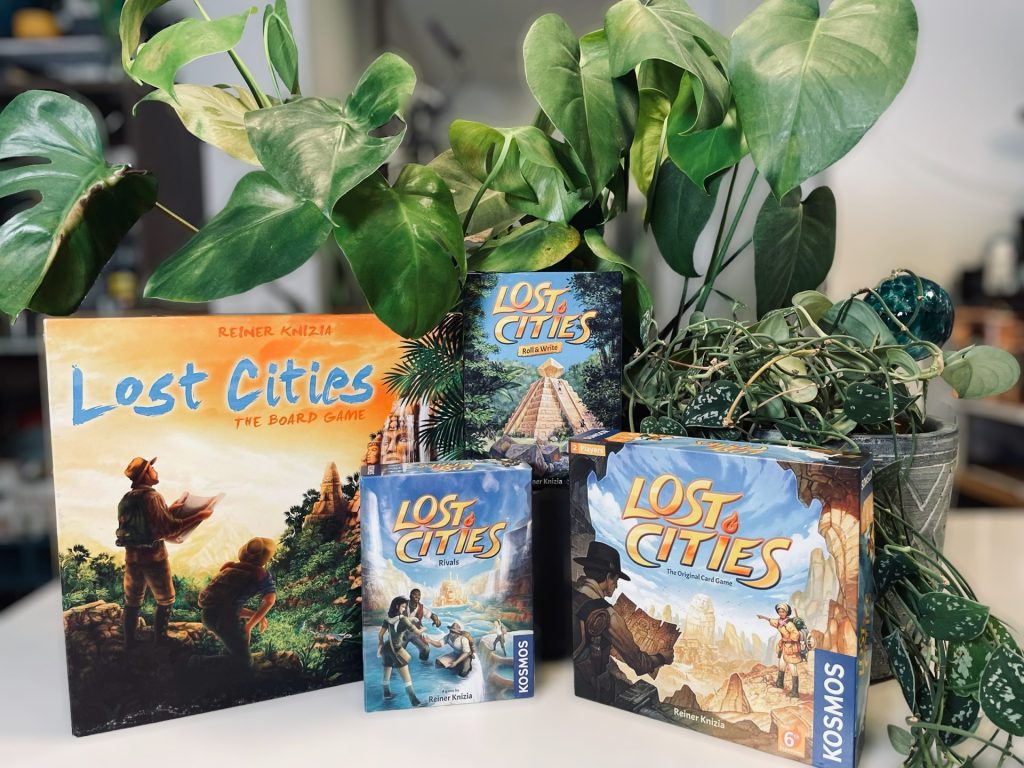
Knizia’s most commercially prominent reimplementations are the games in the Lost Cities series. Starting with the classic 1999 two-player card game, the series includes five different titles, each in a new genre. Four of them have been released in English. Lost Cities: The Board Game is a light family game, Lost Cities: Rivals is an auction game, and Lost Cities: Roll & Write is, well, a roll & write. As a collective, I find the Lost Cities games particularly fascinating because they all manage to elicit the same specific feeling of tension. Once I had a copy of each game, I started wondering just how, exactly, Knizia had managed to take four disparate genres and bend them to feel the same way.
* * * * *
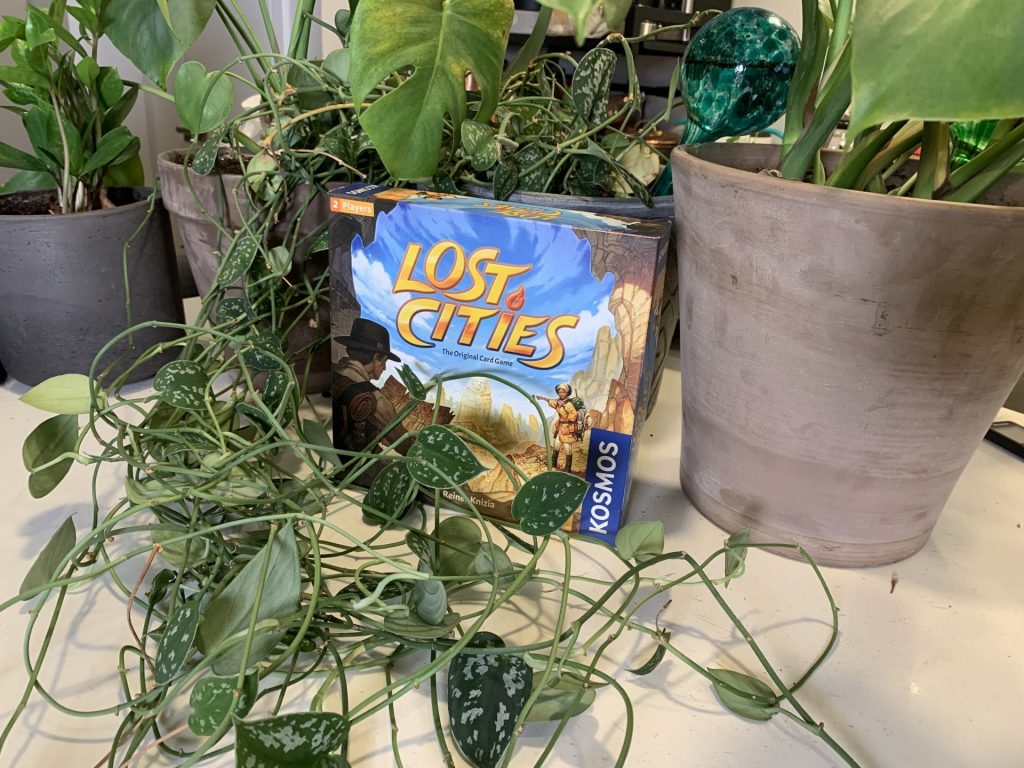
Many of Knizia’s best games create a particular kind of tension by presenting players with an “X, but Y” premise. High Society has players bidding for social status, but spend more than everyone else and you’re out of the game. The burglars of Art Robbery want as much valuable loot as possible, but the higher value pieces don’t come with the alibis you need to keep from being arrested. In Lost Cities, you play as an archaeologist who wants to find as much treasure as possible, but every expedition you start incurs an initial debt that must be paid off.
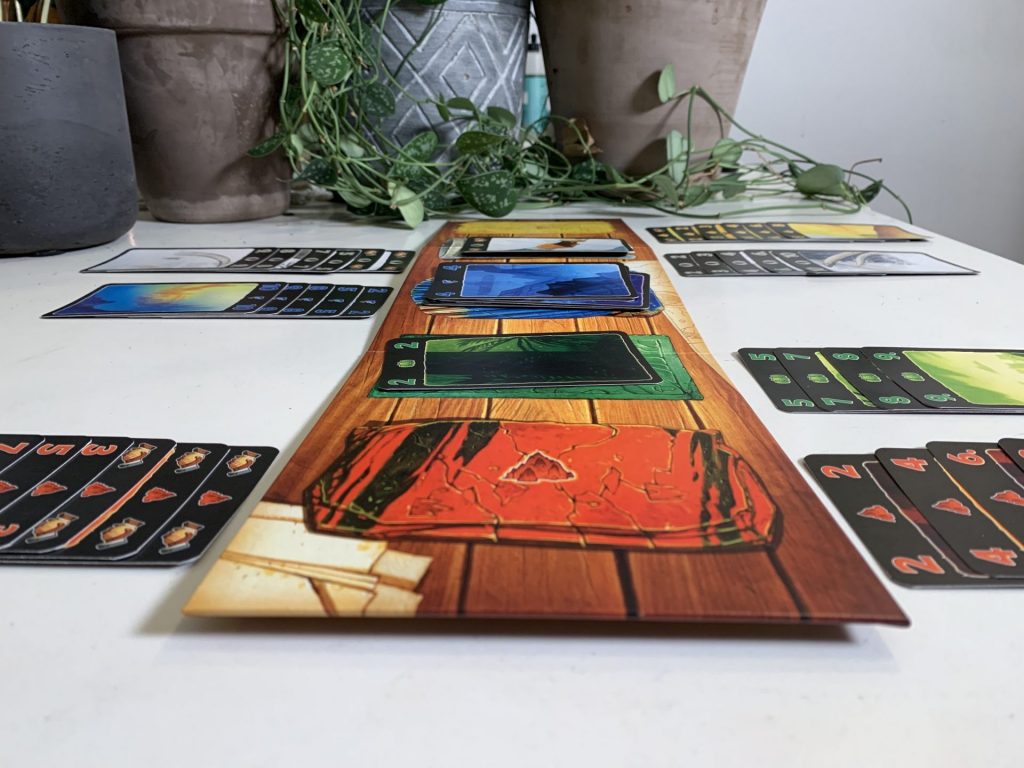 Players take turns placing or discarding a card on their side of the board to one of five columns, playing the card to whichever Expedition matches the card’s suit. Each column has an initial value of -20 the moment you play a card to it. There are also Agreement cards, which double the score for that column, but can only be played at the beginning of the Expedition. In the event that you play an Agreement, the score doubles whether the final value is positive or negative, so a poorly played Agreement card can have a nasty effect on your final score.
Players take turns placing or discarding a card on their side of the board to one of five columns, playing the card to whichever Expedition matches the card’s suit. Each column has an initial value of -20 the moment you play a card to it. There are also Agreement cards, which double the score for that column, but can only be played at the beginning of the Expedition. In the event that you play an Agreement, the score doubles whether the final value is positive or negative, so a poorly played Agreement card can have a nasty effect on your final score.

The tension of Lost Cities comes from the narrow decision space. You can either play a card or discard a card. You cannot pass. Cards have to be played in increasing—though not sequential—order. If you discard a card your opponent wants, they can take it. While the luck of the draw makes the occasional round straightforward, you’re more likely than not to get caught up in brief, agonizing spells of double-think:
It’s early in the game and I have the 4 and the 8 for the Volcano expedition. Should I play the Volcano Agreement card I have in my hand? Will I draw eight more points? Or is it worth playing that 2, 3, and 4 to the Desert just to buy some time and hope I draw more cards I want? My other choice is discarding the Atlantis 5, since I don’t have any other cards in that color, but what if my opponent wants it?
This, I should note, is a game that takes 5-10 minutes tops. I can play a full game on the (excellent) app in less than two.
The other consideration in Lost Cities is tempo. As soon as the last card is drawn from the main deck, the game ends. Neither player gets to play whatever is left in their hand. A big part of the end game is managing the amount of time you—and your opponent—have left:
I have three high cards in one color. Do I hold onto those while I wait for Agreements and other, smaller cards? Doing so could get me 20 bonus points for having eight cards in a single column. If I’m going to do that, I should start discarding cards my opponent can’t play so I can pick them up later, slowing the draw from the deck. Alternatively, I could play those high cards now as a safe bet with lower returns.
Lost Cities is a tense, quick game, and part of what’s so wonderful about it is that the tension only becomes more obvious the more you play. Knizia’s designs often create a particular kind of anguish, a decision space where the options are limited and the implications are significant. The masterstroke of Lost Cities is that you often wish you could pass. It is a card game that takes advantage of the central limitation of card games, that you only know what you have in your hand, and makes it the point of the design.
Lost Cities is often accused of being entirely abstract, but I don’t think that’s true. While there are dozens of games themed around expeditions and exploration that come with all the proper window dressing, including Knizia’s own magnificent The Quest for El Dorado, I think Lost Cities nails the mental space of the theme better than any of them. When you play Lost Cities, you are making decisions about the future, about allocation of time and resources, that are based on partial information and a hunch. Sounds spot on for an expedition to me.
* * * * *
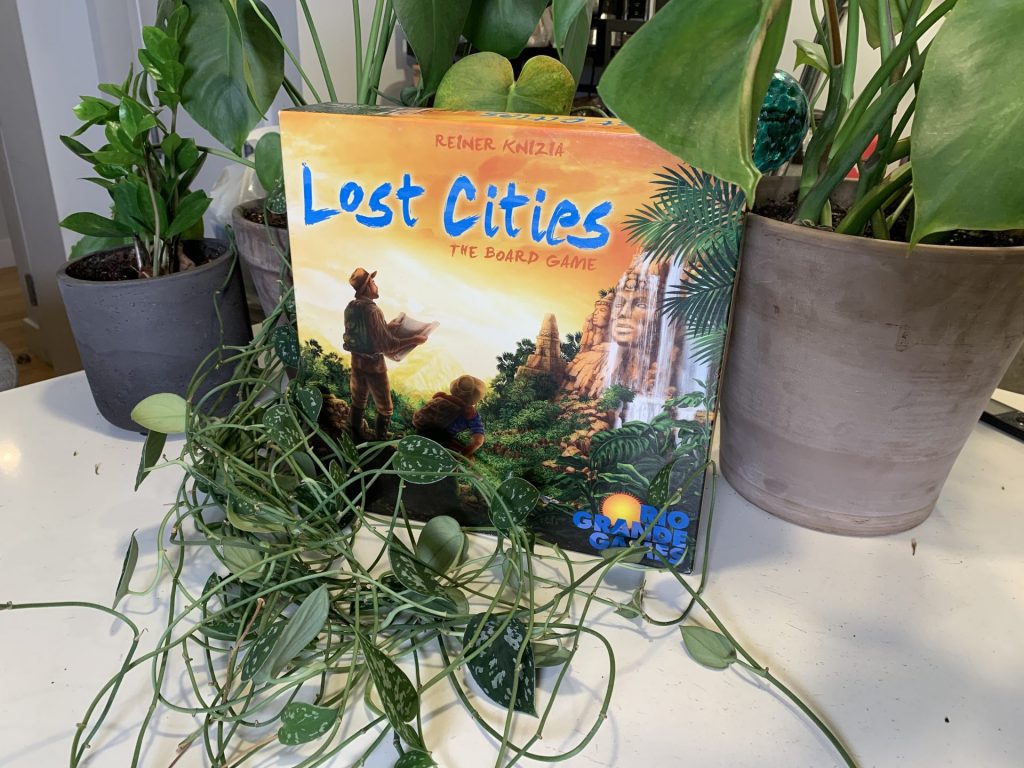
For Lost Cities: The Board Game (LC:TBG), which came out in 2008, players still play cards from five suits in increasing order to matching columns, and your turn is still either playing or discarding a card. If it ain’t broke, why fix it. The adjustments were largely focused on opening the game up to three or four players, and making the game more approachable for young players.
The original Lost Cities is a deeply mathy game. Not knowing the score fits the theme, but would make for a difficult family game. Knowing the scores increases the tension, and LC:TBG takes advantage of the presence of a full board to make the scoring more transparent. Points are no longer calculated based on the value of each player’s cards. Rather, each card you play moves one of your five explorers further along a track of the corresponding color. Each spot on each track is worth an increasing, and initially negative, number of points.
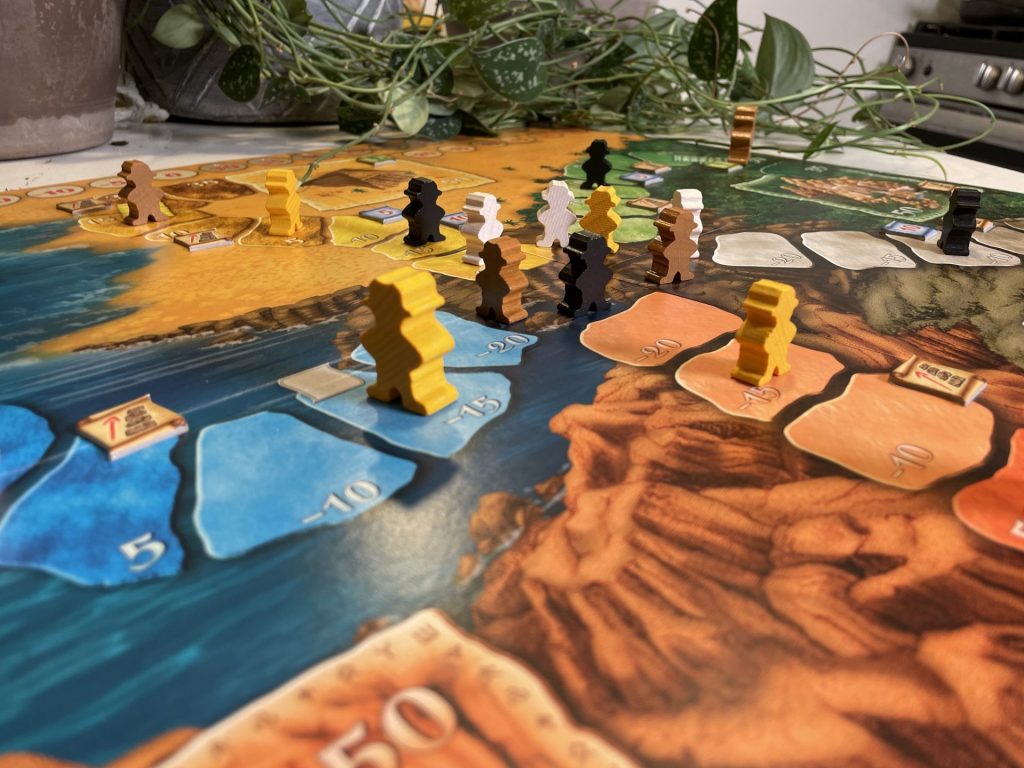 Knizia’s attempt to capture the pacing dynamics of the original is the most successful adjustment. The round can end when the deck runs out of cards or once five explorers have reached the seventh space of any path. After a few games, you start to feel your senses tingle as one, two, then three explorers hop over those rope bridges. Much as a player in Lost Cities might sit on a few high cards to see if they can get that eight card bonus, players with enough cards to make it to the far spaces of the board in LC:TBG may pump the brakes a little before crossing a bridge, hoping to fool their opponents into thinking there’s enough time to start another Expedition.
Knizia’s attempt to capture the pacing dynamics of the original is the most successful adjustment. The round can end when the deck runs out of cards or once five explorers have reached the seventh space of any path. After a few games, you start to feel your senses tingle as one, two, then three explorers hop over those rope bridges. Much as a player in Lost Cities might sit on a few high cards to see if they can get that eight card bonus, players with enough cards to make it to the far spaces of the board in LC:TBG may pump the brakes a little before crossing a bridge, hoping to fool their opponents into thinking there’s enough time to start another Expedition.

Bonus tiles are the big change in this iteration, without precedent in the original design. As players progress up the various paths, they come across tokens that bestow certain advantages. Some give points and some allow the player to move an explorer forward, but the majority are artefacts that score at the end of the game. The tiles are an interesting idea, but they contribute to making the game feel a bit flabby. Lost Cities is as lean as game design gets. With only two players and two possible actions, every choice you make matters. Not so much in LC:TBG. That said, the bonus tiles were not a dead end. Knizia would return to that idea later in the series.
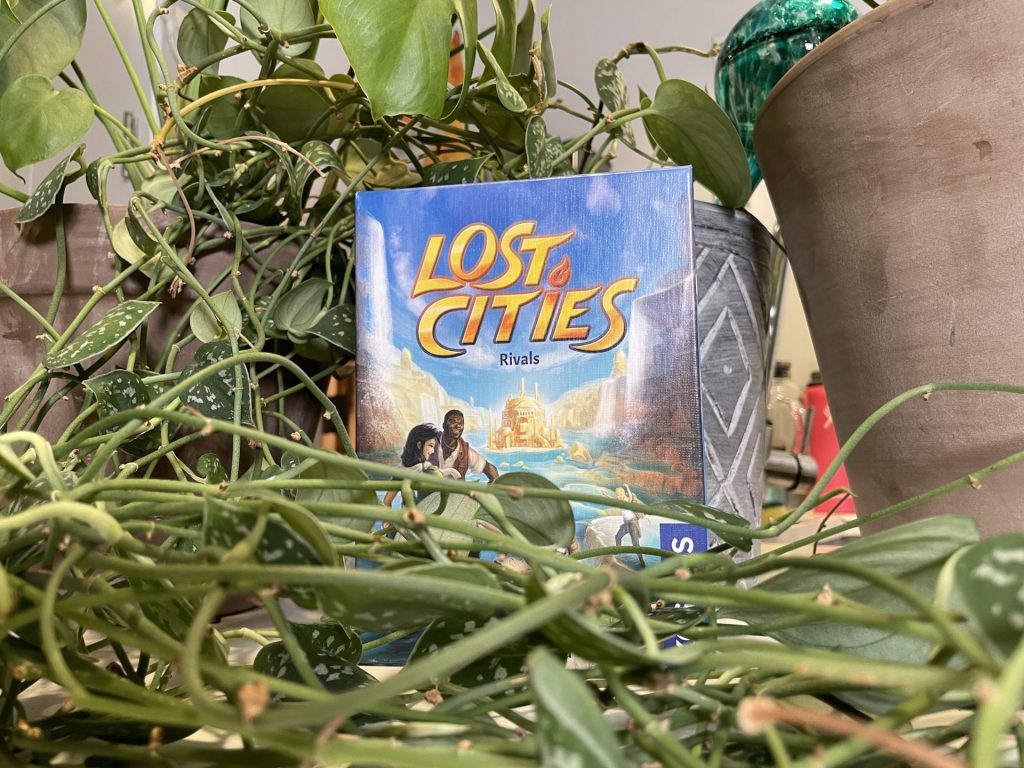
In 2018, Knizia released Lost Cities: Rivals, which re-envisioned Lost Cities as an auction game for 2-4 players. On each player’s turn, they either reveal the top Expedition card from the deck, adding it to a central pool, or they place a bid. In the event of a bid, players take turns either raising the bid or passing, with the high bidder getting to add as many cards from the pool to their display as they want and can. In keeping with the cornerstone rule of the series, Expedition cards must still be played in increasing order. The winner may additionally remove one pool card from the game, which adds incentive for players to bid against one another.
The change that caught my eye when I first read the rules for Rivals was that Expeditions don’t impact your score negatively. Whether you get one card or ten cards in a color, your score will be positive. This seemed like a fundamental violation of the Lost Cities ethos. We must be punished for our folly, oh Lord, for how else shall we learn? I read the rulebook knowing that Rivals is not a terribly well-regarded game, and though the exclusion of negative scoring could be a big part of the problem. Where is the tension going to rest?
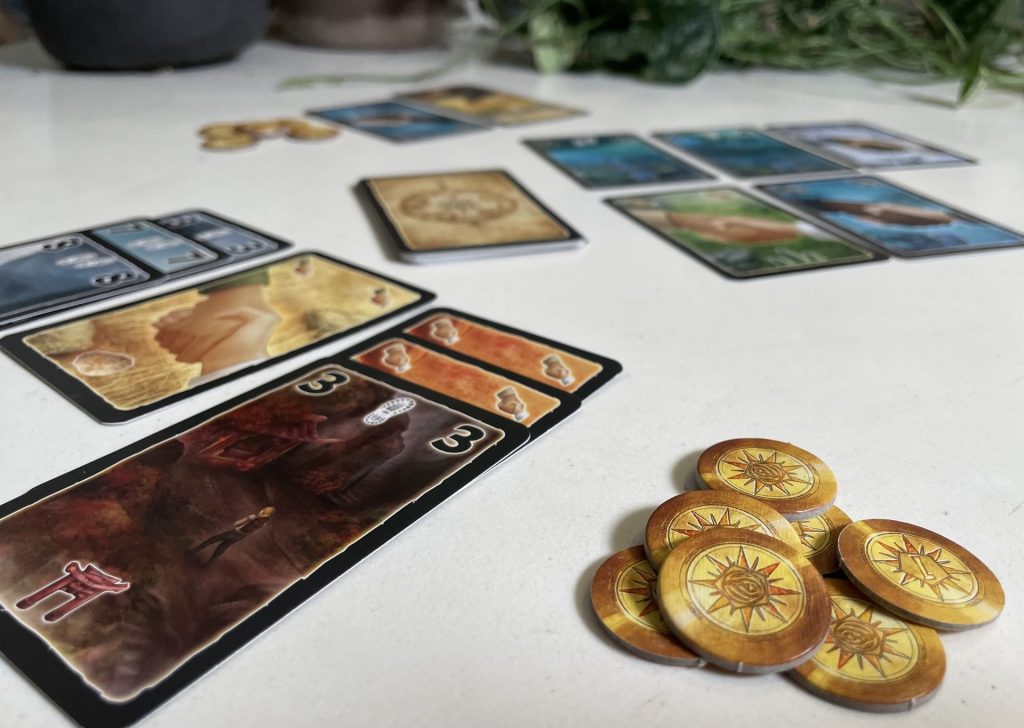 With play, it became obvious that Knizia knew what he was doing. For one thing, if each Expedition in Rivals incurred a debt, nobody would bid for the first half of the game. That sounds awful. Eliminating the possibility of debt ups the pace of play. For another, the debts in Lost Cities are a means to an end. They force the players to think about and fret over the future. In Lost Cities and LC:TBG, that uncertainty manifests as “Should I start this expedition or not?”
With play, it became obvious that Knizia knew what he was doing. For one thing, if each Expedition in Rivals incurred a debt, nobody would bid for the first half of the game. That sounds awful. Eliminating the possibility of debt ups the pace of play. For another, the debts in Lost Cities are a means to an end. They force the players to think about and fret over the future. In Lost Cities and LC:TBG, that uncertainty manifests as “Should I start this expedition or not?”
For Rivals, the focus shifts from if to when. Instead of thinking much about what cards you have and might be able to get in the time remaining, you’re thinking about how much money you have and, crucially, how much money you will have after the current bid. Money is redistributed to the players at three set intervals, when the first three of four draw piles are exhausted. Double-think for Rivals isn’t about the number of points you’ll need later.
I have fourteen coins and my opponents have six and eight. If I raise this bid to seven, I’ll probably win, since it’s unlikely the player with eight coins will want to wipe themselves out for this group of cards. On the other hand, if I do that, I also won’t have the controlling share of money on the table for the next bid, and there are about 16 cards left in the current deck, so I’ll be in the position for a little while.
The central concern of Rivals is about control of the next bid, about whether or not what’s on the table now is worth sacrificing control of what could be there in the future. Lost Cities as a series is all about making the player specifically and acutely aware of the unknown of what’s coming, about weighing the risk and pursuing the reward. Rivals achieves that with ease.
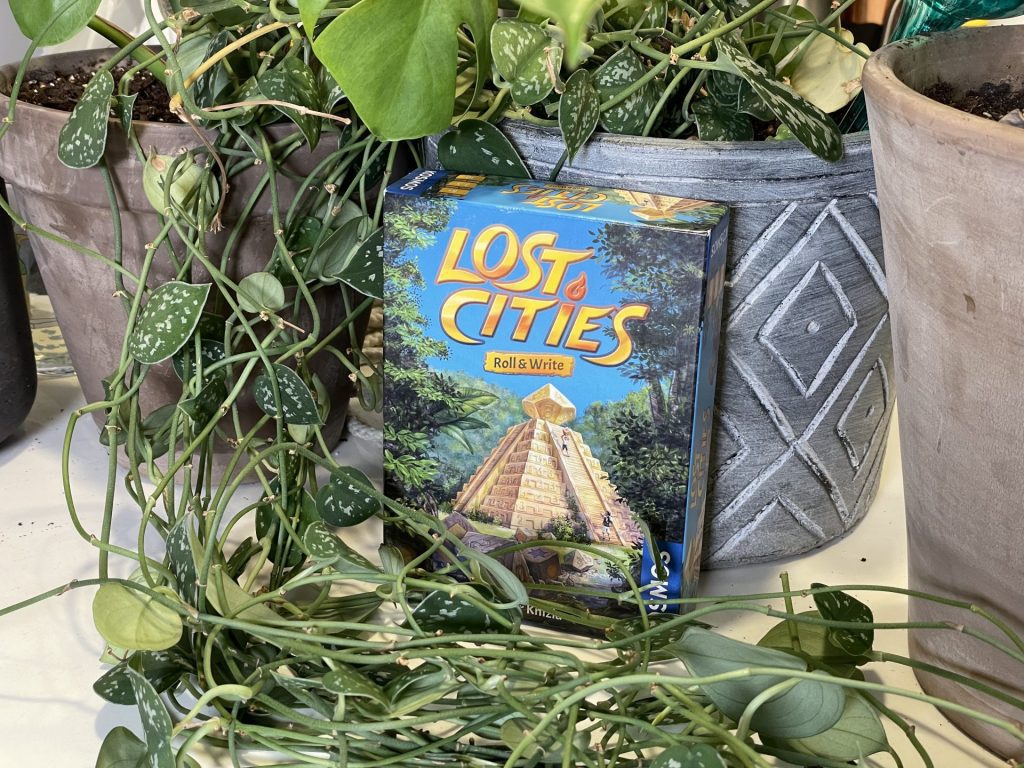
The final entry in the series as of this writing is Lost Cities: Roll & Write, the only game to divorces itself entirely of cards. Obviously, in the transition from cards to dice, significant adjustments had to be made. The five suits have been replaced with six colors, and instead of playing or discarding cards, players take turns rolling dice. Just like in the original, numbers have to be written in increasing order, columns you don’t start will neither gain nor lose you points, and columns that you fill in insufficiently will cost you.
For practical reasons—you can’t discard dice when they don’t provide any options—Knizia added a Pass action. If a player cannot or does not wish to write down any of the thrown results, they can instead cross off one of the boxes in the Pass column. Like every other column, Passing generates points, but unlike the others, it becomes worthless if you fill it up completely. Once again, players are confronted with the tension that comes with not knowing exactly what will happen in the future. Is it better to write down a purple 8 and accept that you’ll need to seize viable purples whenever they come up, or should you pass again?
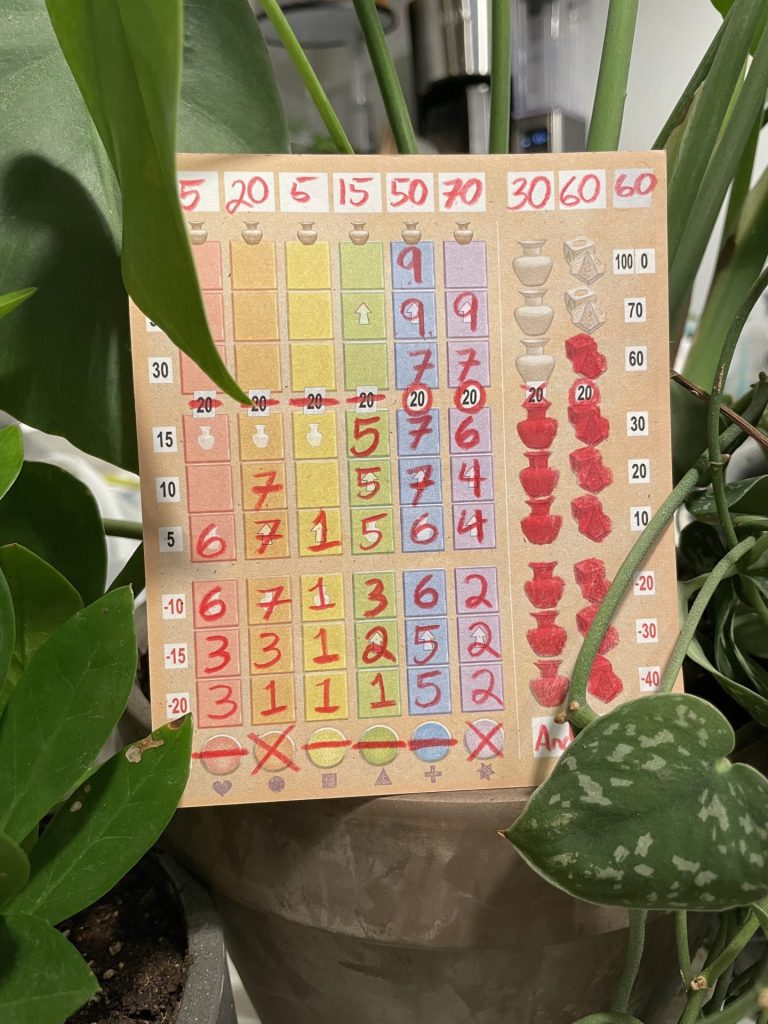
Like LC:TBG, Roll & Write uses a racing mechanic to trigger the end. If every player reaches the top of their Pass column, or if one or more players have reached the seventh box in every column, the game ends. The first player to get to the seventh box in any one column gets extra points, which helps encourage diversity. While the original game discouraged players from focusing on the same Expeditions by nature of the limited supply of cards—if my opponent plays the 7-10 to the Desert, I know there’s not much point in my bothering—Roll & Write offers the carrot of a bonus all your own. There’s no need to rush of course. If you find yourself two or three boxes ahead of everyone else at the table, you may decide to take the opportunity to gain more points in other columns, especially if you’re in the best position to claim the bonus that will end the game.
* * * * *
The Lost Cities games are about the very idea of entropy. They’re designed to make the player uniquely aware of how little control they have over what’s coming while feeling just in control enough to make the journey entertaining and rewarding. Through clever and judicious application of design know how, Knizia found ways to carry the feeling of the original came across the rest of the series. These games are aware of the uncontrollable nature of the card draw or the die roll in a way most games are not. No matter which Lost Cities game you play, you spend the game acutely aware of the fact that you are navigating an unknown future based on the evidence you have at hand.


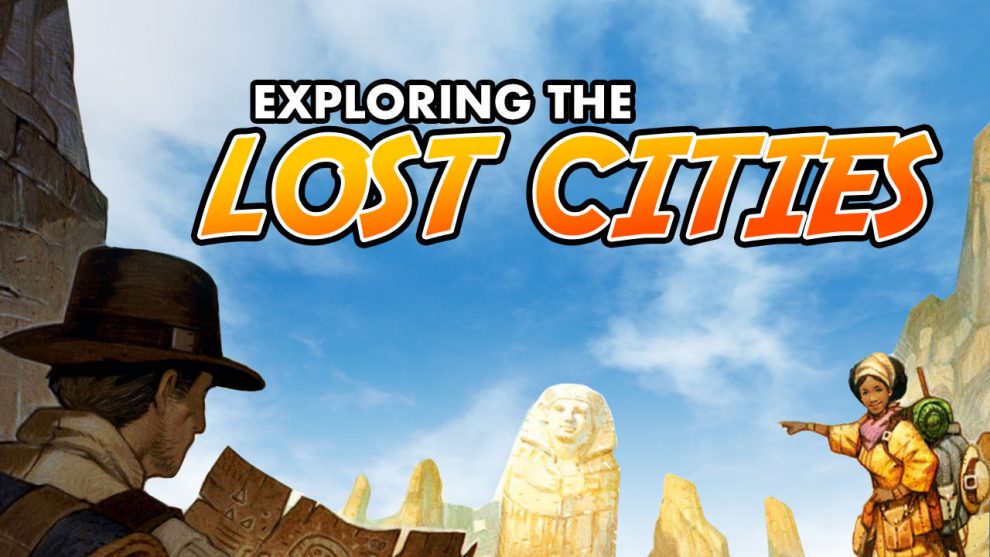








Add Comment